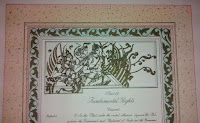On the occasion of celebrating 67 Republic Day, let me present some interesting information about our original Constitution.
Original signed copies of the Constitution of our Country are hand written and each page illuminated by exquisite art work by artists under Acharya Nandalal Bose from Kala Bhavan, Shantiniketan. The original text and Art work of the Preamble was done by Beohar Ram Manohar Sinha. It is said that the signed copies are kept in the safe vault of the Parliament Library in helium filled special cases. Our Constitution of India is considered the longest hand written document of its kind in the world.
Shri Prem Behari Narain Raizada (Saxena) - (1901-1966)
This arduous task of writing 395 Articles and 12 Schedules was entrusted to Calligraphist Shri Prem Behari Naraian Raizada (Saxena) of Delhi. He comes from a family of traditional Calligraphists specialised in Persian and English Calligraphy. His grand father Master Ram Parshadji Saxena was a scholar in Persian and English, who taught Farsi (Persian) to British Government officials. His hand writing was a masterpiece of Calligraphy. Prem Behari's parants died when he was young, and he grewup under his grand father and uncle Mahashya Chatur Behari Narayan Saxena. Shri Prem Behari learnt Calligraphy from his grand father in the traditional way.
 |
| Preamble to Constitution |
Shri Prem Behari Narain Raizada (Saxena) - (1901-1966)
This arduous task of writing 395 Articles and 12 Schedules was entrusted to Calligraphist Shri Prem Behari Naraian Raizada (Saxena) of Delhi. He comes from a family of traditional Calligraphists specialised in Persian and English Calligraphy. His grand father Master Ram Parshadji Saxena was a scholar in Persian and English, who taught Farsi (Persian) to British Government officials. His hand writing was a masterpiece of Calligraphy. Prem Behari's parants died when he was young, and he grewup under his grand father and uncle Mahashya Chatur Behari Narayan Saxena. Shri Prem Behari learnt Calligraphy from his grand father in the traditional way.
 |
Shri Prem Behari Narain Raizada (Saxena)
|
While entrusting this important task of writing the Constitution to Shri Prem Behariji, it is said, Prime Minister Jawaharlal Nehru asked him what he would like to charge as remuneration for the job. Shri Prem Behari replied " Not a single penny I need, by the grace of God I have all things, and quite happy with my life. But I have one reservation, that on every page of Constitution I will write my name and on the last page I will write my name along with my grand father's name". His request was granted and the Government of India allotted him a room in the Constitution House for this prestigious work.
The writing of the Constitution in flowing italic style in the best Calligraphic tradition of our Country was completed by Shri Prem Behariji in six months of hard work. He had used 254 pen holder "No.303" nibs for the job. Shri Prem Behariji has used large and thick parchment paper of 16" by 12" size for his Calligraphy work. The decorative patterns embossed in Gold on the front and back covers of the leather bound volumes are said to be reminiscent of Ajanta Murals. The whole volume of 479 pages weighs 3.75 kg. Photolithographed Copies of the same were made at the office of the Survey of India, Dehradun. Apart from the list of illustrations, the books do not contain detailed index.
Art work and illustrations.
The Art work and illustrations rendered in miniature style, twenty two in all, heads the Twenty two parts of the Constitution. Each picture shown at the head of each Part of Constitution has its relevance and significance of the cultural History of the subcontinent, from the Mohenjadaro period to modern days. To begin with, Part I of the Constitution shows Zebu Bull seal of Harappa, representing Indus Valley Civilization. For Vedic period a scence from Gurukula, and Epic period, Sri Rama from Ramayana
and Gitopadesa from Mahabharata, there are incidents from the lives of Buddha and Mahavira follow in other Parts. Also scences from Ashoka, Vikramaditya, Mahabalipuram and historical figures of Akbar, Shivaji, Guru Gobind Singh, Rani Laxmibai and Tippoo Sultan are also shown in the drawings. The pictures of Mahatma Gandhi and Netaji Subhash chandra Bose are the only representations of our Freedom movement.
There is also picture of Art form from Chola period master piece of Nataraja drawn in a line drawing. The last Part XXII carries scene of ocean the picture of ancient sea faring vessels.
There are also few drawings of beautiful landscape of our Country included in the drawings. Borders of each page is embellished with beautiful decorative art work of Shantiniketan style.
The Constituent Assembly met in eleven sessions open to public for 165 days during the period of 2 years 11 months and 7 days and adopted the Constitution on November, 26, 1949. How ever in all the 284 members of Assembly signed the two hand written copies (one in English and the other in Hindi) only on January 24, 1950. There are 11 pages of these signatures which begins under the Eighth Schedule. First to sign was Jawaharlal Nehru and the last signature is that of Feroze Gandhi. Dr Rajendra Prasad President of the Constituent Assembly has signed two signatures, one in English and other in Hindi.
The Constitution of India came into force on January 26, 1950.
Jai Hind.
 |
| Babu Rajendra Prasad with Prem Behariji |
Art work and illustrations.
 |
| Bull seal of Harappa |
 |
| Sri Rama, Sita and Lakshmana |
 |
| Nataraja of Chola period. |
 |
| Seafaring ships of Cholas |
 |
| Last page |
The Constitution of India came into force on January 26, 1950.
Jai Hind.
No comments:
Post a Comment